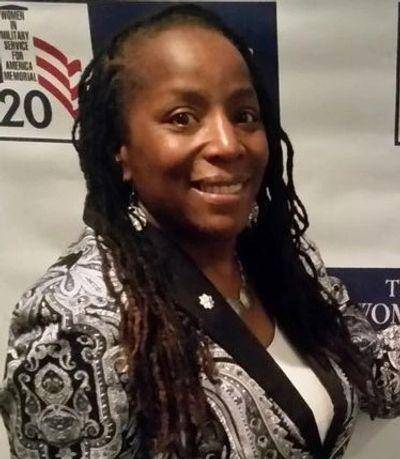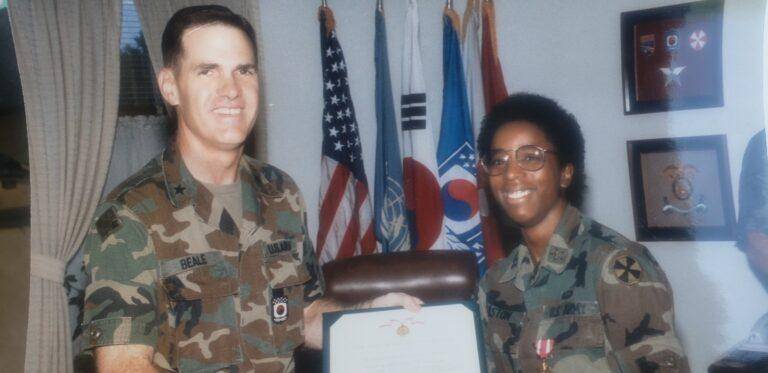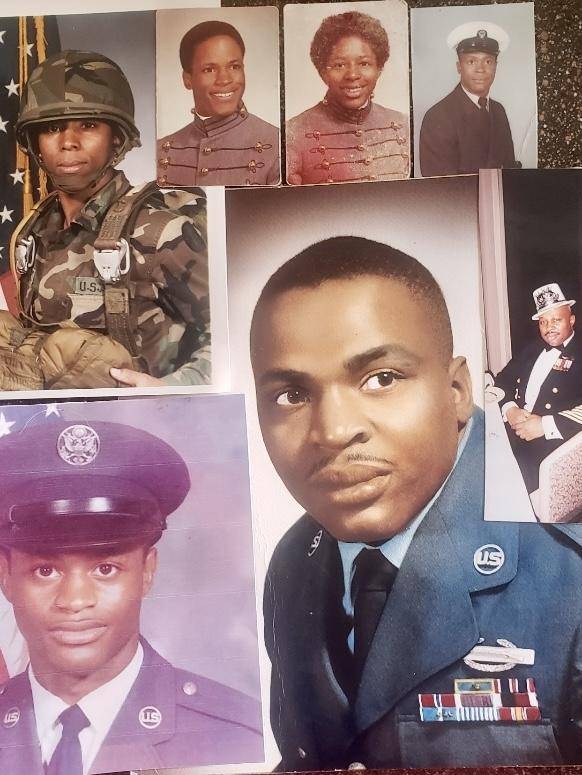by Sue Wolinsky, Family Member

US Army LTC (Ret) Pat Gaston was in a unique position when she served as a Logistics officer for 22 years. She paved the way for future female and black officers. She was:
- the only female in her class at Command General Staff College in the early 1990s;
- one of a very few black, female officers in Logistics in the US Army;
- the first female appointed Chief of Individual Readiness at Fort Jackson.
She also is part of a strong and perhaps unusual military family who collectively served nearly 100 years in the military over two generations. (See Sidebar Story, “Part of a Family that Serves – 100 Years and Counting”).
Even though she retired from the US Army as Lieutenant Colonel (LTC) in 2008 and now lives in NE Albuquerque, she still serves active and retired military in New Mexico. It’s in her blood.
Paving the Way. Before enlisting, Pat earned a special education bachelor’s degree from Texas Women’s University in Denton,TX. She attended her Basic and Advanced Logistical Officer course training at Fort Lee. While stationed at Fort Hood, she served six months, temporary duty, as quartermaster platoon leader of the petroleum unit for Joint Task Force Bravo in Honduras.
She served in Seoul, South Korea, at Yongsan Base, HQ for the US military forces there. As a J-4 officer, one of her biggest missions was turning over the petroleum pipeline running the length of the country to the Koreans and buying $7.4 million of vehicles from the South Koreans for US military branches.
Prior to that assignment, she was the only woman in her class at the Command General Staff College. “It was not inviting to female students,” she said. “It was really miserable,” she said, noting that most of her classmates didn’t respect females. “It showed when we played volleyball (against other classes). The guys would always like to take the ball away from me until the instructor finally said, ‘She actually plays well; let her play.’” An apt description of the challenges she faced.
“A Black female officer was a ‘1%-er’,” she estimated.
“At that time, women comprised only 6% of the military. Of that 6%, only about 2% were officers. A Black female officer was a ‘1%-er’,” she estimates of the military population then.
On the Rise. When she was a captain, she was assigned as HQ Commander at Fort Jackson near Columbia, SC, for 18 months. Ft. Jackson is the US Army’s main training center for Basic Combat Training. They train 50% of all soldiers and 60% of all women entering the Army. While there, she became the first female Chief of the Individual Readiness branch, where she earned the highest evaluation possible. She was promoted to major while stationed at Fort Gillem in Forest Park near Atlanta, GA. (The base was deactivated in 2005.)

following her tour in Korea.
She was a captain when she transferred from active duty to the Reserves and joined a unit in Atlanta, GA. Here she encountered her first openly racist / sexist commander. “He tried to rate me as a #3, down from my previous ratings as #1. I fought it and eventually won,” she said, recalling the good old boys network in place while she was there. Soon after that, she moved to Albuquerque and enlisted in the Ready Reserves as an Individual Military Augmentee (IMA), as there were no reserve units needing her military occupation speciality (MOS) and rank. In this role, she performed her wartime duty during the Kosovo War, as a Petroleum Officer.
Later she was assigned to the 277th Quartermaster Battalion in Albuquerque, where she became a Training Officer, and later to the 809th Quartermaster Detachment (battalion level). She was deployed to Bahrain in the Persian Gulf, Uzbekistan in central Asia, and Kuwait in western Asia. She took command of that unit after deployment and retired two years later.
“Women in the military now need to become
the mentors they wish they had.”
On Mentoring. While serving in Albuquerque, she remembers only one other Black female officer. “I stood out. In my last unit, especially, you could tell by the way they treated you (that they thought) you only got here because of some kind of a quota,” she bitterly recalled.
“You really can’t do anything with people’s prejudices,” she said. “It would have been nice to have a mentor. Not having a mentor and trying to survive in this culture – it did affect me, definitely. Did it affect my effectiveness? Who knows?… I had to work two times, three times harder than other officers,” she said.
“Women in the military now need to become the mentors they wish they had,” she advised.
Since Retiring. Pat started training for her post-military service career two years before she retired. She became a radiological technician at the Raymond G. Murphy VA Medical Center in Albuquerque. She served there for eight years.
From there, she gave life to her passion for helping women veterans make a successful transition to civilian life. She became program manager for the YWCA Henderson House – a transition program for female veterans and children in Albuquerque. Then she and two other women created the Veterans Heading Home Project for the City of Albuquerque, which provided services, especially housing, as well as education to veterans who were dishonorably discharged. “They need help. In many cases, the veteran (while in the service) acted out due to PTSD, got disciplined and eventually was kicked out of the service. This resulted in drinking and/or drugs and they were ineligible to receive any veterans benefits.”
One of her passions since retiring has been growing the Women Veterans of New Mexico (WVNM) organization. She is the President and has served in almost every other leadership role since the group started in 2007. “I do it because I want to give back,” she reflected.
“There are lots of women out there who don’t know the benefits and services they’ve earned, so a lot of women don’t take advantage of them.”
WVNM has 100 active members and 200 names on the inactive rolls. They meet quarterly and the next meeting is 31 July at 10am at the Golden Corral Restaurant, 5207 San Mateo Blvd, NE (Zoom link available). One of the group’s goals is to attract younger female veterans and get them involved – keep the legacy. They also are trying to change the public’s perception of a modern-day veteran from a 22-year-old male to a much broader range of women and men, younger and older, with and without families, etc. “Giving back; that’s what I am doing,” she said.
Proudly She Served
The WVNM’s mission is to serve as an educational resource for women living in New Mexico, or neighboring states, who currently serve in U.S. armed services, NM National Guard or Reserves, or are veterans separated under honorable or general terms.

Part of a Family that Serves — 100 Years and Counting
US Army LTC (Ret) Pat Gaston was born on Dyess Air Force Base near Abilene, TX.
She lived on military bases as a child, with her eight siblings, living as far away as Tripoli, Africa, when she was a toddler.
As an adult, she lived on US Army bases all over the world during her 22 years of service. And nearly all of her siblings served in the US military, too. Together, this family tallied nearly 100 years of military service over two generations. This may be a record; maybe not. But whether it is or not, impressive is an understatement.
“We followed in dad’s footsteps. He was in the Army, then the Air Force. I have two brothers who were in the Navy (one serving on a submarine and one on a surface warship), one brother in the Air Force, and a sister and brother (twins) who graduated from West Point. The three youngest of us were officers in the Army and the other three enlisted. My brother, Patrick, and I were in Logistics. We both were stationed at Fort Hood, TX, at the same time for our first assignments — without either one of us knowing it initially. We were on opposite sides of the post, but we had the same motor pool. “And, one time, his unit rescued my unit’s equipment in the field,” she recalled, laughingly. “We both were promoted to First Lieutenant together. I was in 22 years, dad did 24 and my oldest brother did 23,” she said as she tallied up an estimate of their years of service. Another brother served over 20 years, as well. Add the years that the other siblings served and the family tally nears 100 years!
Serving concurrently with siblings had its responsibilities and its benefits. “My older sister went to West Point,” Gaston said, noting that they looked a lot alike. “We often got mistaken for each other. And we met each other’s friends as we served all over the world.”
She and her brother, Patrick, served at the same time in Iraqi Freedom in 2003. While he was in Tikrit, Iraq, and she was in Kuwait, she helped his unit out. After his unit lost a CONEX (stackable container used in mass sea and land transportation of goods – CONtainer EXpress), she started looking for the lost container, found it, and had it sent directly to his unit. “This was important because some of the guys only had one uniform (because of the lost container),” she said. She also saw that they got toilet paper (which was in short supply up north) and neck cooling bandanas to help battle the desert heat. She and her brother also had some of the same bosses at different times while they served. Her battalion commander at Fort Hood years later was Patrick’s Commander – the Army’s Logistics Officer in the Pentagon.

remarkable!!!